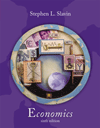 |
1 |  | 
When an American store buys camcorders from a Japanese firm, this purchase is paid for in |
|  | A) | gold. |
|  | B) | dollars. |
|  | C) | yen. |
|  | D) | Euros. |
 |
 |
2 |  | 
In 2000 our balance of current account was about |
|  | A) | -$100 billion. |
|  | B) | -$200 billion. |
|  | C) | -$300 billion. |
|  | D) | -$400 billion. |
|  | E) | -$500 billion. |
 |
 |
3 |  | 
The main reason why we are running huge current account deficits is because we are |
|  | A) | running huge capital account surpluses. |
|  | B) | running huge merchandise trade deficits. |
|  | C) | running huge service trade deficits. |
|  | D) | running huge federal budget surpluses. |
 |
 |
4 |  | 
The world's currencies were based on gold until |
|  | A) | 1900. |
|  | B) | the 1930s. |
|  | C) | the 1950s. |
|  | D) | the 1980s. |
 |
 |
5 |  | 
Statement I. An exchange rate is the price of a country's currency in terms of another currency. Statement II. Under the gold standard, a negative balance of trade causes an outflow of gold. |
|  | A) | Statement I is true and statement II is false. |
|  | B) | Statement II is true and statement I is false. |
|  | C) | Both statements are true. |
|  | D) | Both statements are false. |
 |
 |
6 |  | 
The world has had a freely floating exchange rate system since |
|  | A) | 1900. |
|  | B) | 1933. |
|  | C) | 1945. |
|  | D) | 1973. |
|  | E) | 1994. |
 |
 |
7 |  | 
Over the last few years the dollar has been traded for |
|  | A) | less than 50 yen. |
|  | B) | less than 75 yen. |
|  | C) | over 100 yen. |
|  | D) | over 125 yen. |
|  | E) | over 150 yen. |
 |
 |
8 |  | 
When a nation's currency declines relative to other currencies, the main effect is that it makes that nation's imports _____ expensive and its exports _______ expensive. |
|  | A) | more, more |
|  | B) | less, less |
|  | C) | more, less |
|  | D) | less, more |
 |
 |
9 |  | 
Which is the most accurate statement? |
|  | A) | Now that the federal budget deficit has been turned into a surplus, it is safe to say that our financial house is in order. |
|  | B) | As a nation, we have been living well beyond our means for over 20 years. |
|  | C) | As long as foreigners keep accepting our dollars, there will be no consequences if we let our trade and current account imbalances keep growing rapidly. |
|  | D) | Over the next few years we'll probably see the dollar rise very sharply against the other leading currencies. |
 |
 |
10 |  | 
Statement I. We are the world's largest debtor nation. Statement II. We are the world's only economic superpower. |
|  | A) | Statement I is true and statement II is false. |
|  | B) | Statement II is true and statement I is false. |
|  | C) | Both statements are true. |
|  | D) | Both statements are false. |
 |
 |
11 |  | 
We are running a trade _____ and a current account _____. |
|  | A) | deficit, deficit |
|  | B) | surplus, surplus |
|  | C) | deficit, surplus |
|  | D) | surplus, deficit |
 |
 |
12 |  | 
Our net foreign debt is now over |
|  | A) | $100 billion. |
|  | B) | $500 billion. |
|  | C) | $1 trillion. |
|  | D) | $2 trillion. |
 |
 |
13 |  | 
Which is the most accurate statement? |
|  | A) | Foreigners will soon own America. |
|  | B) | Within five years over one quarter of all Americans will work for foreign-owned companies. |
|  | C) | Foreign banks provide about 30 percent of all business loans in the U.S. |
|  | D) | Japan owns more American assets than any other country. |
 |
 |
14 |  | 
Which one of the following is not a reason for the Japanese to build automobile plants in the United States? |
|  | A) | to save the shipping costs from Japan |
|  | B) | to invest their dollars in a politically stable country |
|  | C) | to place themselves within any tariff wall that may be erected in the future |
|  | D) | to work their way into a position where they can control most of the American economy |
 |



 2002 McGraw-Hill Higher Education
2002 McGraw-Hill Higher Education